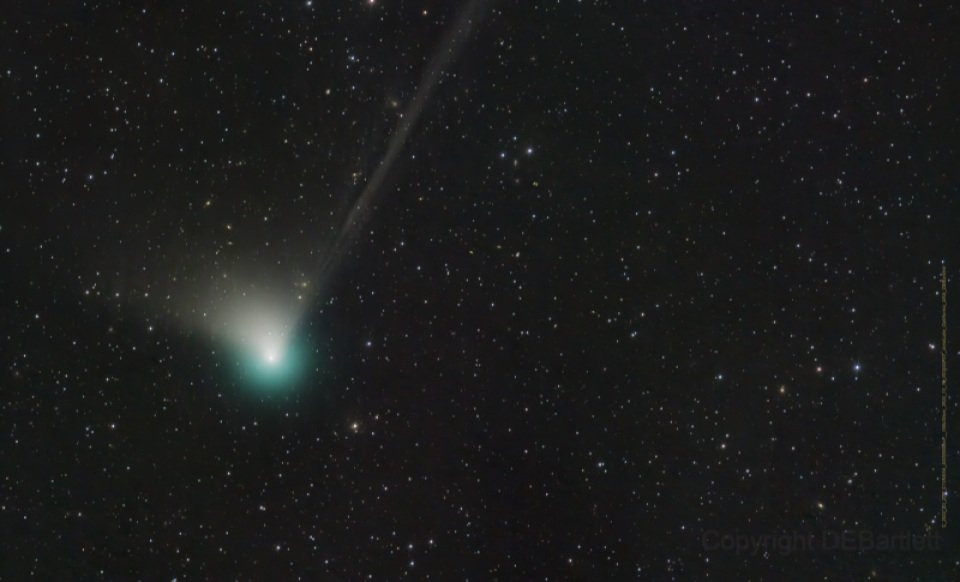By The Landlord
“I came in with Halley's Comet in 1835. It is coming again next year, and I expect to go out with it. It will be the greatest disappointment of my life if I don't go out with Halley's Comet. The Almighty has said, no doubt: ‘Now here are these two unaccountable freaks; they came in together, they must go out together.’” – Mark Twain
Imagine one ancient evening, it being 50,000 years ago, you've been going about your daily business of hunting, fighting, fucking, and generally clubbing it with your neighbours over some leftovers around the camp fire. You're a straight-up emerging, perhaps gradually migrating, Homo Sapiens, or heavier build Sapiens Neanderthalensis. You've had to deal with a lot of danger, hunger and bad weather, and you may, unknowingly, be gradually expanding that brain, but really you're just getting by. But then you look up in the sky and see an extraordinary green comet passing through the sky. It has an enormous tail spurting in sparks of endless fire. Everyone is pointing and also grunting. Are you terrified or just curious? Is this the end of the world or a portent of something else? Is it a giant dragon? Or is it just a distraction while your greedy neighbour grabs that tasty animal leg bone you had your eye on? Either way, it's a very rare event, and an experience you won't forget, especially because it's just the stone age, there's no telly or much else to do at night other than sleep badly, sometimes with one eye open. And also because it won't happen again, well not for 50,000 years.
But now that particular astral body, actually known as "a dirty snowball", is currently visible with the naked eye or better binoculars, in your skies for the first time since that profound last sighting. The catchily named comet C/2022 E3 (ZTF) has been calculated to orbit the sun every 50,000 years, emerging from the Oort Cloud at the edge of the solar system, an area described by NASA as "like a big, thick-walled bubble made of icy pieces of space debris", up to 465 billion miles away. The comet was first seen in March 2022 as it made its way through Jupiter's orbit. Currently it is visible to north of our skies, currently close to Polaris star, a mere 27 million miles from us, so no danger of it dropping in.
Look north: what we might see, clouds permitting, of C/2022 E3 rare visit
But like that enormous comet and its tail, what trails this week's topic are rare events and experiences, but what defines rare, or even unusual or unique? That's subjective of course, but it would have to be something that happens only once, perhaps twice in anyone's lifetime, and the key point, in lyrics or title, is it is as much about the perception, experience and telling of that rarity as the definition itself. So it might be the sighting of a celestial body, but also a more earthly body, a unique experience with an unusual person, perhaps of the romantic kind, or otherwise. Or a strange other kind of event - a disaster, or extraordinary piece of luck or chance. Justifications, lyrical quotes, and further descriptions are always valuable, as, of course, is imagination and lateral thinking.
We've had various space-related themes in the past, and some songs about celestial bodies are in the archives, but that doesn't discount anything more on this, including comets, or indeed asteroids or other such major natural events, as long as they are related as experiences, rather than just mentioned in passing.
We have all been shaped by our past of course, not least as emergence of mammals out of the disastrous impact of Chicxulub crater created by a six-mile wide asteroid 66 million years ago that did for the dinosaurs. Hopefully not likely to repeat for a long time yet, though we may be burning things out sooner in the Holocene. Long before the Chicxulub crater, Earth had a bigger one at Vredefort in South Africa more than 2 billion years ago.
Rare, certainly in recorded history, on 30 November 1954, a grapefruit-sized piece of the Sylacauga or Hodges meteorite fell on a farm house in Oak Grove, Alabama, near Sylacauga, in the United States. It crashed through the roof, bounced off a large wooden console radio, and hit resident Ann Elizabeth Hodges (1920–1972) while she napped on a couch. Luckily, thanks to that, er, radio interference, she was only badly bruised on one side of her body, but was able to walk and able to take photos showing the fresh wound. But talk about a rude awakening.
But some aren't so lucky. In 1677, according to a manuscript published at Tortona in Italy tells of a Milanese friar killed by a meteorite, though he might have just had an argument with a neighbour. But the Tunguska event in Russia of 1908 was certainly a rare and devastatingly true and rare event, caused by meteor air burst, reported to have caused three deaths.
More recently, on the night 3 October 2021, a meteorite fell through the roof of a house in Golden, British Columbia, landing on a sleeping resident Ruth Hamilton's pillow, but without harming her. Unlucky for the roof, but extremely lucky for her head. Either way, very rare. Sweet dreams aren't made of this.
Rude awakening. Meteorite on Ruth Hamilton’s pillow, 2021
Such astral bodies, falling or not, may inspire all kinds of religious or psychological reactions. Or simply paranoia, as shown in the form the Asterix books character of portly shield-carrying Gaul Chief Vitalstatistix, whose his biggest fear is that the sky will fall down on him.
Looking up, again, there are many other comet sightings that could be deemed rare, including of course, Halley's, which generally appears once every 75 years. Mark Twain's remark in 1909 proved extraordinarily accurate. It appeared in 1835, his year of birth, and then again in 1910, on 20 April, when it was first photographed. Twain died the very next day, his final words were written with a pencil: “Give me my glasses.”
Detail of Halley’s comet depicted events of 1066 on the Bayeux Tapestry
Halley's comet has appeared in some key years. In 837 its closet ever passing of only 5 million km away, when its tail apparently stretched halfway across the sky and appeared as bright as Venus. It was in the skies in 1066 of course, as depicted in the Bayeux Tapestry and the invasion of England at the Battle of Hastings by William The Conqueror. And then like clockwork since, noted by various Chinese, Japanese and Italian astrologers, such as in 1222 when it was described in Japan "as large as the half Moon . . . Its colour was white but its rays were red", and named after himself by the second Royal Astrologer Edmond Halley in London in 1682. It last appeared in 1986 and comes next in 2061:
Here's what, a the great Carl Sagan had to say about it, and with a certain portent, about Earth:
At the present rate of change, it seems likely that in the period between now and 2061, the turning point for the human species will have been reached. If we survive until then, our passage to the next apparition of Halley's Comet should be comparatively easy. That perihelion passage will be in March 2134, when the comet will make an unusually close encounter with the Earth. It will come as close as 0.09AU or 14 million kilometres, less than half the distance of the 1910 encounter. It will then be brighter than the brightest star. If there are those to do the commemorating, the years 2061 and 2134 should be celebrated for the courage, intelligence, and common purpose of a species forced by urgent necessity to come to its senses.” Let's hope he's right, and we do.
There are other comets that may also come up too. Did anyone see the twin tails of Hale-Bopp, discovered independently on July 23, 1995, by Alan Hale and Thomas Bopp?
The 1577 comet - big in Europe
Others of note are the 1577 comet that lit up across Europe, or the Great Comet of 1811 (C/1811 F1) was visible to the naked eye for around 260 days. It inspired all kinds of art, including the satirical Looking at the comet till you get a criek in the neck, by Thomas Rowlandson in that year (see above) and also William Blake, who included the body in his extraordinary Ghost of a Flea of 1820. No doubt, as we'll discover, this week, it also inspired much music.
Ghost of a Flea, by William Blake (1820), which includes depiction of the Great Comet of 1811
But you may prefer to think laterally about other kinds of events or experiences highlighted in song. Rare to some may be common to others, there are some people who do seem rare, those trailblazers who seem of the once-in-a-lifetime kind. They might have a rare effect on others, and live extraordinary lives, and some bizarre or rare deaths. The ethical philosophical pioneer, Socrates for one, whose trial and death is well documented, or tragedian Aeschylus, whose life ended tragically, in a way that couldn't even be made up, apparently killed when a hungry eagle dropped a tortoise on his head. The bird's idea was that the shell would break and the eagle could eat the meat, but mistook his bald head for a rock. If only he'd been looking to the sky, like Chief Vitalstatistix. Things certainly weren't looking up for the great dramatist.
Surviving an extraordinary death might count here just as much as not making it. Violet Jessop, for example, also known as Miss Unsinkable, was an Argentine woman of Irish heritage who worked as an ocean liner stewardess, memoirist, and nurse in the early 20th century. She survived the Titanic in 1912 , then and her sister ship the HMHS Britannic in 1916, but earlier than both the RMS Olympic, when it collided with the British warship HMS Hawke in 1911.
Unsinkable Sam, or Oscar the cat. A rare survivor
Jessop is only really matched by “Unsinkable Sam" was the nickname of a ship’s cat who survived being the ship's on the Nazi Bismarck, was sunk by the HMS Cossack in 1941, then found in the water by the British, who took him aboard, and named him Oscar. Later in the war, the HMS Cossack sank after being hit by a torpedo, killing 159 crew members. Oscar survived again. He was also on the HMS Ark Royal torpedoed, by a Nazi U-boat, survived, and retired to Belfast, adopted by a seaman, finally succumbing to old age in 1955. Certainly gives paws for thought.
But perhaps even rarer story is that Vesna Vulović, born in Serbian region of the former Yugoslavia, a flight attendant on JAT Flight 367 bound for Copenhagen, who somehow survived a fall of 33,000 feet when the aircraft was exploded by a briefcase bomb on 26 January 1972. Ironically, she wasn’t even scheduled to fly that day, but was booked in due to some name confusion, with another flight attendant of the same first name.
The woman who fell to Earth: Vesna Vulović with a certain musician …
Just a few examples of rare lives, sights and sounds, extraordinary deaths, one-off experiences, events and encounters with people of all kinds, or just someone who seems that way? How will you perceive rare in this lyrical context? Did you manage to get a glimpse of C/2022 E3, this time round, and what will the world be like when it next visits in another 50,000 years? Will there even be a world to view it from, or will the next form of humans be able to travel with it?
Place your suggestions in comments below, and picking through the rarities is our own special guest and keeper of rare finds in the Marconium, the marvellous Marco den Ouden! Deadline is 11pm on Monday UK time, for playlists published next week. So let’s look to the skies, or elsewhere, hoping the real, or metaphorical clouds will part, and ideas will blaze a trail.
New to comment? It is quick and easy. You just need to login to Disqus once. All is explained in About/FAQs ...
Fancy a turn behind the pumps at The Song Bar? Care to choose a playlist from songs nominated and write something about it? Then feel free to contact The Song Bar here, or try the usual email address. Also please follow us social media: Song Bar Twitter, Song Bar Facebook. Song Bar YouTube, and Song Bar Instagram. Please subscribe, follow and share.
Song Bar is non-profit and is simply about sharing great music. We don’t do clickbait or advertisements. Please make any donation to help keep the Bar running:








